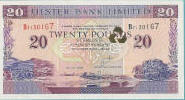Banknote
|
|
A banknote (more commonly known as a bill in the United States and Canada) is a kind of currency, issued as legal tender. With coins, banknotes make up the cash forms of all modern money. With the exception of non-circulating high-value or precious metal commemorative issues, coins are generally used for lower valued monetary units, while banknotes are utilised for higher values.
Originally, the value of money was determined by the intrinsic value of the material the money was made of, such as silver or gold. However, carrying around a lot of precious metal was cumbersome and often dangerous. As an alternative, banknotes would be issued. In financial terms, a note is a promise to pay someone money. Banknotes were originally a promise to pay the bearer an amount of precious metal stored in a vault somewhere. In this way the stored value (usually in gold or silver coins) backing the banknote could transfer ownership in exchange for goods or services.
The ability to exchange a note for some other kind of value is called "convertibility". For example a US silver certificate from the early 20th century was "payable in silver on demand" from the Treasury. If a note is payable in demand for a fixed unit, it is said to be fully convertible to that unit. Limited convertibility occurs when there are restrictions in the time, place, manner or amount of exchange.
Today, this is no longer true; the currency of all countries is now fiat money not backed by gold or silver. There are a few alternative currency systems such as the Liberty dollar which are so backed, or the Ithaca Hours which are backed by the labor of the people of Ithaca, NY.
The perception of banknotes as money has evolved over time. Originally, money was based on precious metals. Banknotes were seen as essentially an I.O.U. or promissory note: a promise to pay someone money, but not actual money. As banknotes became more widely used, they became more accepted as equivalent to precious metal. With the gradual removal of precious metals from the monetary system, banknotes are now simply considered as money.
History
Paper money originated in two forms: drafts, that is receipts for value held on account, and "bills", which were issued with a promise to convert at a later date.
Money is based on the coming to pre-eminence of some commodity as payment. The oldest monetary basis was for agricultural capital: cattle and grain. In Ancient Mesopotamia, drafts were issued against stored grain as a unit of account. A "drachma" was a weight of grain. Japan's feudal system was based on rice per year – koku. At the same time, legal codes enforced the payment for injury in a standardized form, usually in precious metals. The development of money then comes from the role of agricultural capital and precious metals having a privileged place in the economy.
Such drafts were used for giro systems of banking as early as Ptolemaic Egypt in the first century BC.
However the use of paper money as a circulating medium is intimately related to shortages of metal for coins. In the 600s there were local issues of paper currency in China and by 960 the Song Dynasty, short of copper for striking coins, issued the first generally circulating notes. A note is a promise to redeem later for some other object of value, usually specie. The issue of credit notes is often for a limited duration, and at some discount to the promised amount later. The original notes were restricted in area and duration, but the Yuan Dynasty, facing massive shortages of specie to fund their occupation of China, began printing paper money without restrictions on duration. By 1455, in an effort to rein in economic expansion and end hyperinflation, the new Ming Dynasty ended paper money, and closed much of Chinese trade.
In Europe the first banknotes were issued by Stockholms Banco, a predecessor of the Bank of Sweden, in 1660, although the bank ran out of coins to redeem its notes in 1664 and ceased operating in that year. It was 1694 when the Bank of England issued the first permanently circulating banknotes. The use of fixed denominations and printed banknotes came into use in the 18th century.
The ease with which paper money can be created, by both legitimate authorities and counterfeiters, has led both to a temptation in times of crisis such as war or revolution to produce paper money which was not supported by precious metal or other goods, thus leading to hyperinflation and a loss of faith in the value of paper money, e.g. the Continental Currency produced by the Continental Congress during the American Revolution, the Assignats produced during the French Revolution, the paper currency produced by the Confederate States of America, the financing of the First World War by the Central Powers (by 1922 1 gold Austro-Hungarian krone of 1914 was worth 14,400 paper Kronen), the devaluation of the Yugoslav Dinar in the 1990s, etc.
Australian_$10_note_1988.jpg
See also
For information about banknotes of particular countries or of the European Union:
- Australian banknotes
- British banknotes
- Canadian banknotes
- Euro banknotes
- Irish banknotes
- Polish banknotes
- Turkish banknotes
- United States banknotes

